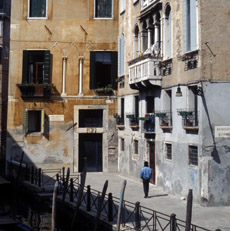index
Venice
The narrative quality of Venice almost overpowers you. It seems to have been built because of all the stories and films about it. It provides its own commentary. Flowing and still water. You see a Roman cardo and decumanus: the grand canal, extended in the line between the Guidecca and San Giorgio, crossed by the main S-curve of the fondamenta. Parallel curves for the old axes; it seems appropriate, yet it twines through a maze. The spatial modulation of walking in Venice: narrow, high, blind ends, wide two sided, one sided open, varying warmth and air, water, stone, occasional greenery, water still surprising you. Huge campi I missed the other day, probably passing them very close, but you don't know what is behind the line of buildings. The rhythm is in your choice as you walk; it punctuates moods, creates a story with suspense, or a random labyrinthine quality, with unexpected convergences influences crossing with your thoughts and talking and vision. Parts are like Treviso or other cities, but there are no cars and little freight on the walkways. A restricted language of formal variations on small number of types. A grammar of use that takes up the uniqueness of the setting. The qualities simplify at the edges, but in different ways in different areas: high at ghetto, straight beyond, single buildings, compounds, green, and so on. The center has these mixed, or in potency. So has Venice become an object rather than a city? No, but it is a city with a much more self-conscious self-presentation. A themed place, if you will, whose theme is itself and its own history.

